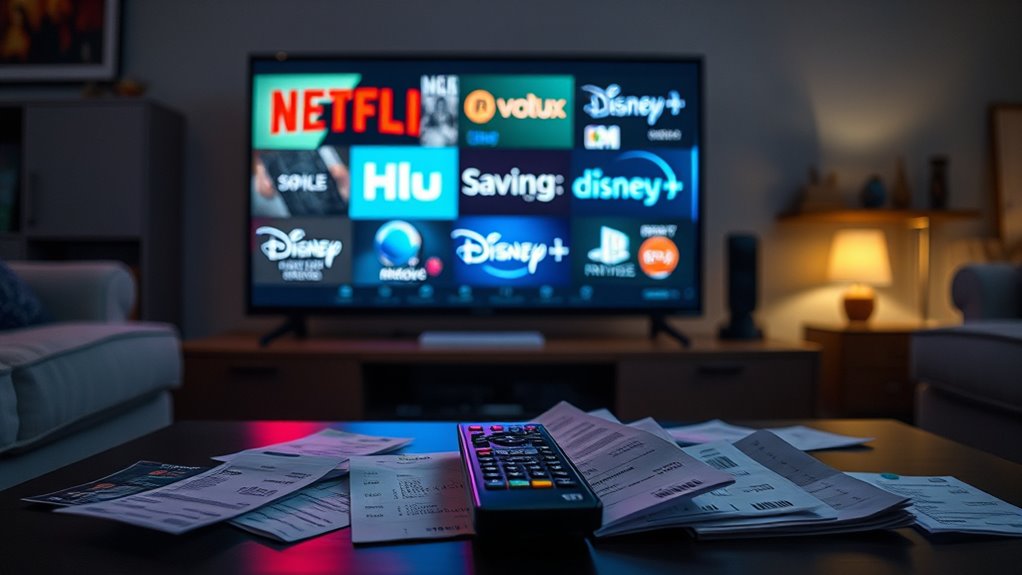Many streaming services can cost more than you realize, especially with hidden fees, extra charges for multiple users, and policy restrictions on sharing. While basic plans seem affordable, adding premium options, channels, or sports bundles quickly raises bills to rival or surpass traditional cable costs. To save money, it’s vital to review each platform’s policies and consider which services truly match your viewing habits. Keep going to discover how you might cut costs without sacrificing your favorite content.
Key Takeaways
- Streaming costs often surpass traditional cable bills due to multiple subscriptions, add-ons, and hidden fees.
- Extra charges for equipment, device upgrades, and household sharing restrictions can inflate overall expenses.
- Policy changes and stricter account sharing rules increase household costs for multi-user streaming.
- Bundled live TV and sports packages can be costly, sometimes rivaling cable bills, especially with regional surcharges.
- Customizing subscriptions, using ad-supported plans, and cancelling unused services can significantly reduce streaming expenses.
How Much Are Streaming Services Really Costing You?

While streaming services often seem affordable on a month-to-month basis, the true cost can add up quickly when you factor in multiple subscriptions, add-ons, and hidden fees. Content licensing agreements mean each platform invests heavily to secure exclusive shows, driving up prices for consumers. Additionally, the user interface varies across services, often requiring you to navigate different apps and search through cluttered menus, which can lead to accidental purchases or subscribing to multiple platforms. Many services push premium tiers with ad-free experiences, increasing costs further. When you tally these expenses—multiple subscriptions, extra channels, and add-ons—it’s easy to see how your monthly streaming bill surpasses initial expectations, making it more expensive than traditional cable in the long run. Moreover, diverse designs of streaming packages can make it difficult to select the most cost-effective options.
Comparing Streaming to Traditional Cable Expenses

In 2025, streaming services are increasingly matching the monthly costs of traditional cable plans, making it harder for you to find significant savings. While cable costs range from $120 to $165 monthly, streaming bundles now often reach $75–$95, especially with added features. Content licensing and regional availability influence prices—regional sports or local channels can drive up costs on both platforms. Here’s a comparison:
| Service Type | Typical Monthly Cost | Key Factors |
|---|---|---|
| Traditional Cable | $120–$165 | Regional availability, content licensing fees |
| Streaming Basic | $10–$20 | Content licensing, limited regional access |
| Streaming Premium | $75–$95 | Add-ons, local channels, regional restrictions |
| Bundled Cable/Stream | $75–$100 | Regional availability, package deals |
| Extra Content Fees | Varies | Content licensing, regional restrictions |
Both options involve regional and licensing complexities, influencing your overall costs. Additionally, content licensing costs can fluctuate, further affecting pricing strategies for both cable and streaming services.
Hidden Fees and Extra Charges in Streaming Plans

You might think your streaming plan covers everything, but hidden fees can turn your bill higher than expected. Extra equipment charges, price hikes, and regional surcharges often catch users off guard. Staying aware of these charges helps you avoid surprises and better understand your total streaming costs. Additionally, understanding the true benefits of eye patches can guide you in selecting effective skincare products.
Additional Equipment Fees
Hidden fees and extra charges often inflate the true cost of streaming plans beyond the advertised price. One common hidden cost involves additional equipment fees. You might need to upgrade hardware for better device compatibility or to support new features. These charges can include:
- Purchasing or renting streaming devices like smart TVs, streaming sticks, or gaming consoles
- Hardware upgrades to improve resolution or performance
- Extra remote controls or hardware accessories
- Fees for specialized equipment to access premium content
- Costs for network hardware improvements, such as routers or modems
These hidden equipment costs can quickly add up, especially if your current setup isn’t compatible with newer streaming features. Be aware that some services require specific hardware, making hardware upgrades an unavoidable part of maintaining seamless streaming. Additionally, some plans may have additional service fees that are not immediately obvious during the initial sign-up process.
Price Increases and Surcharges
Many streaming services have increased their base prices, and even those advertised as affordable can quickly become costly once surcharges and extra fees are added. Content licensing costs drive price hikes, leading providers to implement regional surcharges to cover licensing restrictions or local market conditions. These surcharges vary by region and can profoundly inflate your monthly bill. Additionally, some services charge extra for access to local stations, sports packages, or premium content, further boosting costs. Middlemen like cable or internet providers often add their own fees, making the total expense even higher. Without careful scrutiny, you might pay for a seemingly affordable plan only to discover hidden fees and surcharges that push your monthly expenses well beyond the advertised price. Being aware of affiliate disclosures ensures you understand how your purchases support content creation and site maintenance.
The Impact of Multi-User and Password Sharing Policies

As streaming services tighten restrictions on password sharing, you may find yourself paying more if you want extra users on your account. Many platforms now charge additional fees for household members beyond the main subscriber, which can quickly increase your monthly costs. These policies aim to boost revenue but could make managing household streaming expenses more complicated and expensive. Additionally, understanding the Relationships – Personality Test can help users navigate shared accounts and communicate effectively about these changes.
Password Sharing Restrictions
Password sharing has become a common way for households to maximize their streaming budgets, but recent restrictions are changing that dynamic. Streaming services are tightening rules to limit account sharing outside households, often requiring verification through streaming devices or login alerts. These policies may involve:
- Monitoring account activity across multiple devices
- Restricting simultaneous streams on different locations
- Implementing parental controls to prevent unauthorized access
- Charging extra fees for additional users or devices
- Using device verification to confirm household boundaries
These restrictions aim to curb revenue loss but can complicate multi-user access and increase costs. If you share accounts with friends or family outside your household, you might find yourself paying more or facing restrictions. Managing these policies requires awareness of each service’s rules and potential extra fees. Additionally, understanding well-being tips can help users navigate the stresses associated with these new policies more effectively.
Extra User Fees
Have recent changes to streaming policies increased the costs for households sharing accounts? Yes. Streaming services are tightening user account management by implementing extra user fees and stricter restrictions on password sharing. Many platforms now offer tiered subscription options that include additional charges for multiple users or household members. For example, Netflix’s extra member fees range from $6.99 to $7.99 per month, depending on the plan and ad level. These fees aim to curb unauthorized sharing and boost revenue from multi-user households. As a result, what was once a simple shared account now might cost considerably more if you add multiple household members. This shift pushes household streaming costs higher, making it essential to understand each platform’s subscription tiering and user management policies. Additionally, some platforms are implementing cookie policies to monitor and enforce account sharing restrictions more effectively.
Household Cost Impacts
Tighter policies on multi-user access and password sharing are substantially raising household streaming costs. Content licensing restrictions now limit how many devices or locations can stream simultaneously, forcing you to pay more for additional users. These policies aim to protect revenue but impact user convenience, often requiring extra fees for family or multi-device plans. Furthermore, the use of professional-grade content licensing complicates streaming rights, leading to increased costs for consumers. These changes push household costs higher, making it harder to keep streaming affordable while balancing content licensing rights and user convenience.
The Rising Price of Live TV and Sports Streaming

As streaming services compete to offer live TV and sports, prices are rising sharply, making it more expensive to access these premium channels. Many platforms now require sports subscriptions that include regional surcharges, which can substantially increase monthly costs. For example, adding local sports networks often involves extra fees, pushing streaming bills beyond initial estimates. Live sports packages are increasingly bundled with other channels or offered as costly add-ons, making it tough to find affordable options. You might pay a base rate of around $70–$80 but face additional charges for regional sports and premium content. This trend means that, despite cutting the cord, your total monthly bill for live TV and sports streaming can rival or exceed traditional cable prices, squeezing household budgets even further.
Are Bundles Saving You Money or Increasing Costs?

Bundling multiple streaming services can seem like a way to save money, but it often ends up increasing your overall costs. While bundle savings can reduce monthly bills, they may lead to paying for channels or features you don’t need. For example:
- You might subscribe to a Disney+ and Hulu bundle for $19.99/month but still pay separately for premium add-ons.
- Combining services often results in paying for multiple ad-supported and ad-free tiers.
- Cost comparison shows that subscribing to individual services can sometimes be cheaper than bundles if you skip unnecessary channels.
- Bundles can encourage unnecessary upgrades, increasing total expenses.
- Hidden fees and overlapping content may further inflate costs, making bundles less economical than they seem at first glance.
- Utilizing natural materials in your streaming setup, like wooden media consoles or vintage decor, can also influence your overall home entertainment costs by encouraging a cozy, rustic aesthetic.
Tips to Cut Streaming Expenses Without Losing Content

You can reduce streaming costs without sacrificing your favorite content by being strategic about your subscriptions. Customizing subscriptions lets you pick plans that suit your viewing habits, avoiding unnecessary extras. Consider switching to ad-supported plans, which offer significant savings while still providing access to popular shows and movies. For example, opting for Hulu’s ad-supported package or Netflix’s lower-tier plan can cut monthly expenses without losing key content. Evaluate which services you use most and cancel or pause subscriptions for less-watched platforms. Bundling a few essential services can also reduce overall costs. Remember, you don’t have to pay for multiple premium tiers—choosing the right balance of ad-supported plans and customized subscriptions helps you enjoy your favorite content without overspending.
Frequently Asked Questions
How Do Regional Sports Fees Impact Overall Streaming Costs?
Regional sports fees substantially increase your overall streaming costs. You might start with a basic plan, but adding regional sports channels or networks can lead to hidden charges that inflate your bill. These fees often aren’t included in the initial subscription price, making your monthly expenses higher than expected. To save, look for streaming services that bundle regional sports or offer cheaper alternatives, helping you avoid unexpected costs.
Are Free Trial Periods Truly Cost-Free or Do They Lead to Hidden Charges?
Free trial pitfalls often present promise without payment, but hidden charges lurk behind the scenes. You might forget to cancel, resulting in surprise subscriptions and sudden charges. Some services require credit card details upfront, risking automatic billing after the trial ends. Always scrutinize terms, set reminders, and read the fine print to avoid unexpected expenses. Don’t assume trials are truly free; vigilance prevents costly, concealed charges from catching you off guard.
Can Combining Multiple Services Reduce Total Monthly Streaming Expenses?
Yes, combining multiple services can reduce your total monthly streaming expenses through bundle discounts and service aggregation. By subscribing to bundled packages like Disney+ and Hulu, you often get savings compared to individual plans. Service aggregation allows you to access multiple platforms with a single payment or account, cutting costs and simplifying billing. Just watch out for extra add-ons or premium channels that might offset those savings.
How Does Password Sharing Affect Individual Streaming Service Costs?
Password sharing can increase your streaming costs if you’re not careful, as many services now limit account security by restricting multiple users or locations. To manage subscriptions effectively, you might need to pay extra fees for additional users, raising your total expenses. Proper subscription management guarantees you avoid unexpected charges, keeping your costs predictable while maintaining secure account access for everyone in your household.
Are There Affordable Alternatives to Expensive Live TV Streaming Packages?
Think of streaming bundles as a toolbox—offering multiple tools at a lower price. Affordable alternatives to expensive live TV packages include choosing smaller, specialized streaming services, using free or ad-supported platforms, or bundling services with discounts. You can also explore local channels via digital antennae or consider streaming packages that focus solely on your favorite content, helping you cut costs while still enjoying the shows you love.
Conclusion
Like Icarus soaring too close to the sun, you might think you’re saving by chasing endless streaming deals, only to find costs soaring higher than expected. Stay grounded by evaluating what you truly need, just as Odysseus navigated treacherous waters wisely. With a clear eye and strategic choices, you can avoid the siren song of hidden fees and rising prices, ensuring your entertainment budget doesn’t become your own personal labyrinth.









